Analyzing Environmental Justice in Local Power Plants and Landfills
VerifiedAdded on 2020/04/21
|7
|1499
|252
AI Summary
This research examines the concept of environmental injustice in relation to local power plants and landfill operations, arguing that while these entities can cause harm through mismanagement or poor regulation, they are not inherently unjust when properly managed. The study highlights the shift towards using renewable resources like methane from landfills for electricity generation, emphasizing economic benefits and societal needs over limited environmental impacts. It underscores the importance of distinguishing between conceptual injustice and human error in addressing broader social consequences.
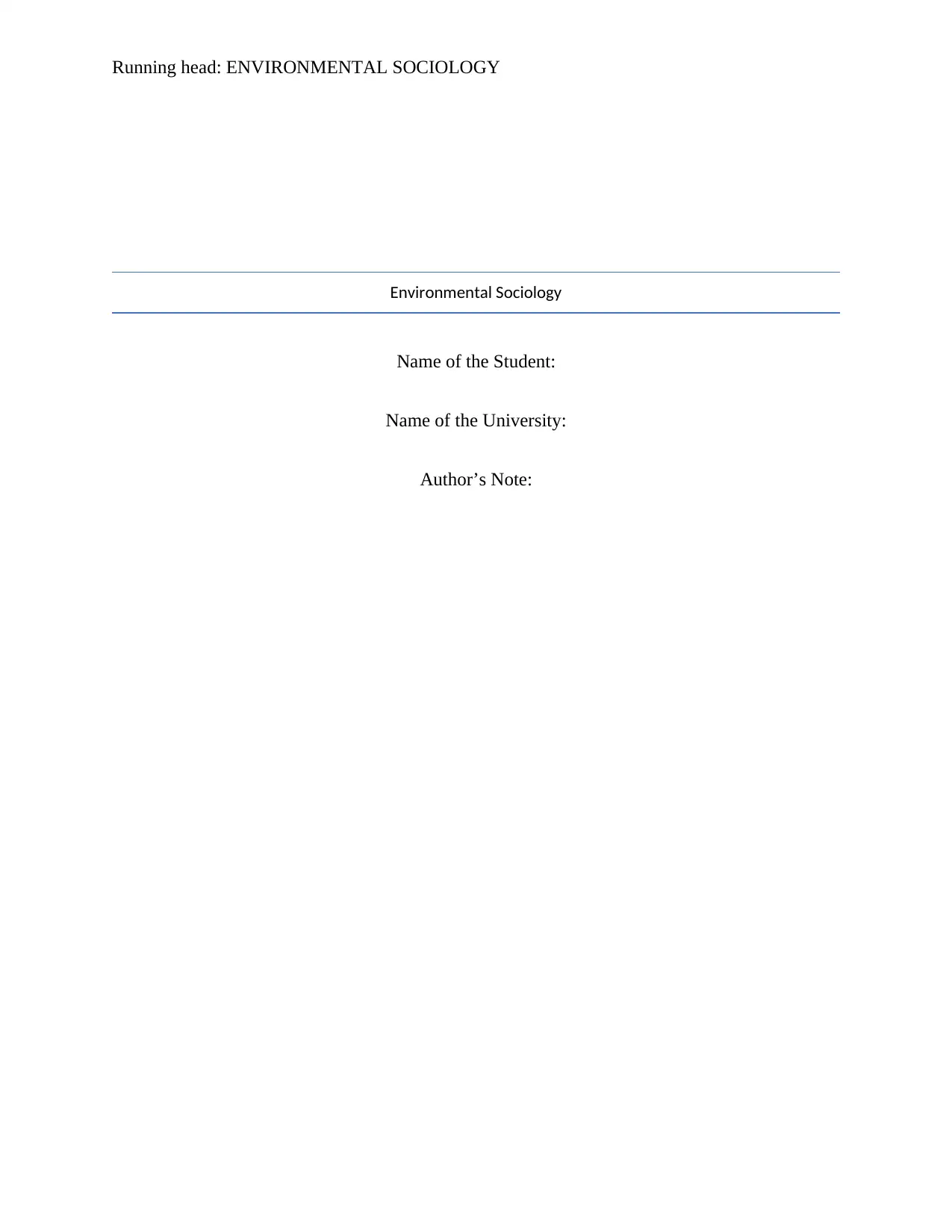
Running head: ENVIRONMENTAL SOCIOLOGY
Environmental Sociology
Name of the Student:
Name of the University:
Author’s Note:
Environmental Sociology
Name of the Student:
Name of the University:
Author’s Note:
Paraphrase This Document
Need a fresh take? Get an instant paraphrase of this document with our AI Paraphraser
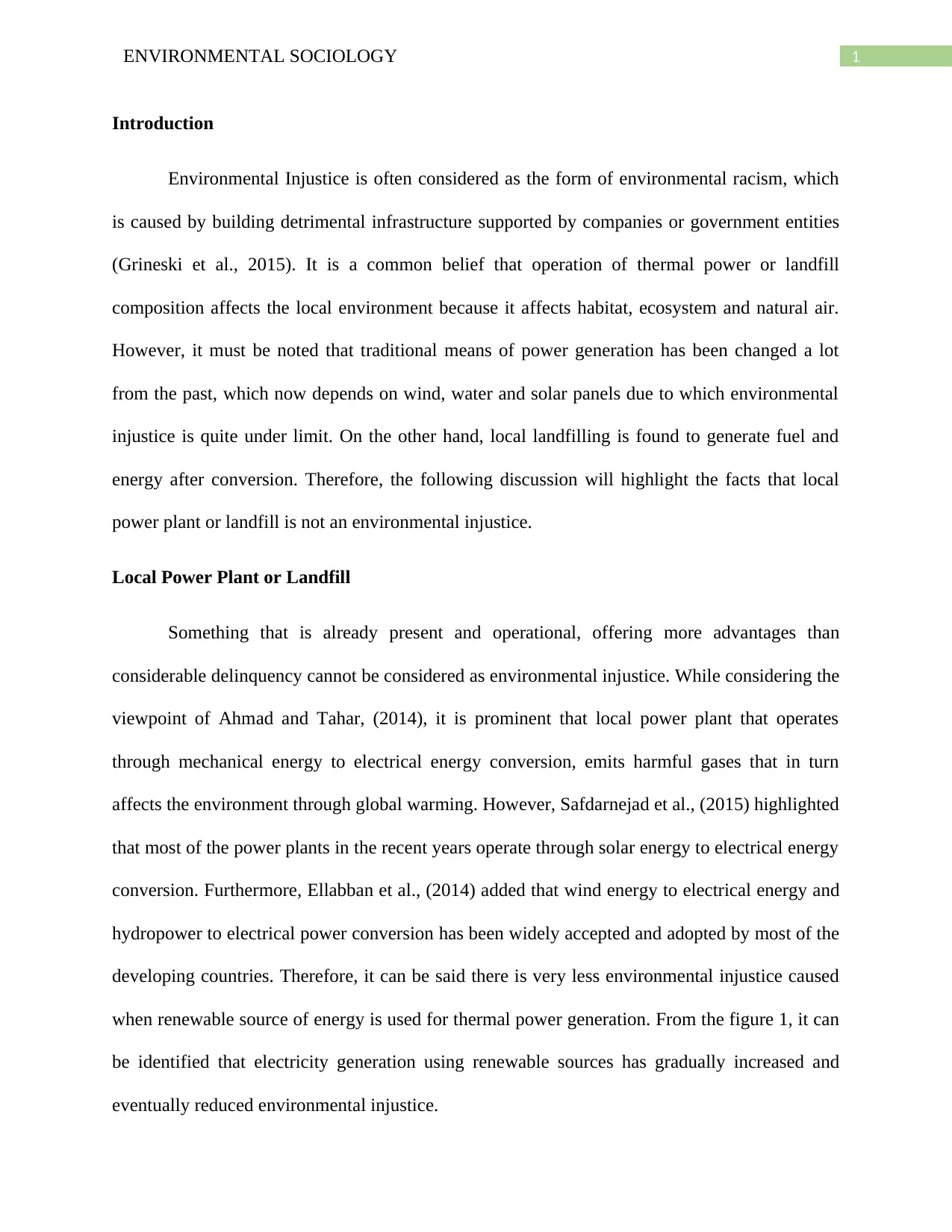
1ENVIRONMENTAL SOCIOLOGY
Introduction
Environmental Injustice is often considered as the form of environmental racism, which
is caused by building detrimental infrastructure supported by companies or government entities
(Grineski et al., 2015). It is a common belief that operation of thermal power or landfill
composition affects the local environment because it affects habitat, ecosystem and natural air.
However, it must be noted that traditional means of power generation has been changed a lot
from the past, which now depends on wind, water and solar panels due to which environmental
injustice is quite under limit. On the other hand, local landfilling is found to generate fuel and
energy after conversion. Therefore, the following discussion will highlight the facts that local
power plant or landfill is not an environmental injustice.
Local Power Plant or Landfill
Something that is already present and operational, offering more advantages than
considerable delinquency cannot be considered as environmental injustice. While considering the
viewpoint of Ahmad and Tahar, (2014), it is prominent that local power plant that operates
through mechanical energy to electrical energy conversion, emits harmful gases that in turn
affects the environment through global warming. However, Safdarnejad et al., (2015) highlighted
that most of the power plants in the recent years operate through solar energy to electrical energy
conversion. Furthermore, Ellabban et al., (2014) added that wind energy to electrical energy and
hydropower to electrical power conversion has been widely accepted and adopted by most of the
developing countries. Therefore, it can be said there is very less environmental injustice caused
when renewable source of energy is used for thermal power generation. From the figure 1, it can
be identified that electricity generation using renewable sources has gradually increased and
eventually reduced environmental injustice.
Introduction
Environmental Injustice is often considered as the form of environmental racism, which
is caused by building detrimental infrastructure supported by companies or government entities
(Grineski et al., 2015). It is a common belief that operation of thermal power or landfill
composition affects the local environment because it affects habitat, ecosystem and natural air.
However, it must be noted that traditional means of power generation has been changed a lot
from the past, which now depends on wind, water and solar panels due to which environmental
injustice is quite under limit. On the other hand, local landfilling is found to generate fuel and
energy after conversion. Therefore, the following discussion will highlight the facts that local
power plant or landfill is not an environmental injustice.
Local Power Plant or Landfill
Something that is already present and operational, offering more advantages than
considerable delinquency cannot be considered as environmental injustice. While considering the
viewpoint of Ahmad and Tahar, (2014), it is prominent that local power plant that operates
through mechanical energy to electrical energy conversion, emits harmful gases that in turn
affects the environment through global warming. However, Safdarnejad et al., (2015) highlighted
that most of the power plants in the recent years operate through solar energy to electrical energy
conversion. Furthermore, Ellabban et al., (2014) added that wind energy to electrical energy and
hydropower to electrical power conversion has been widely accepted and adopted by most of the
developing countries. Therefore, it can be said there is very less environmental injustice caused
when renewable source of energy is used for thermal power generation. From the figure 1, it can
be identified that electricity generation using renewable sources has gradually increased and
eventually reduced environmental injustice.
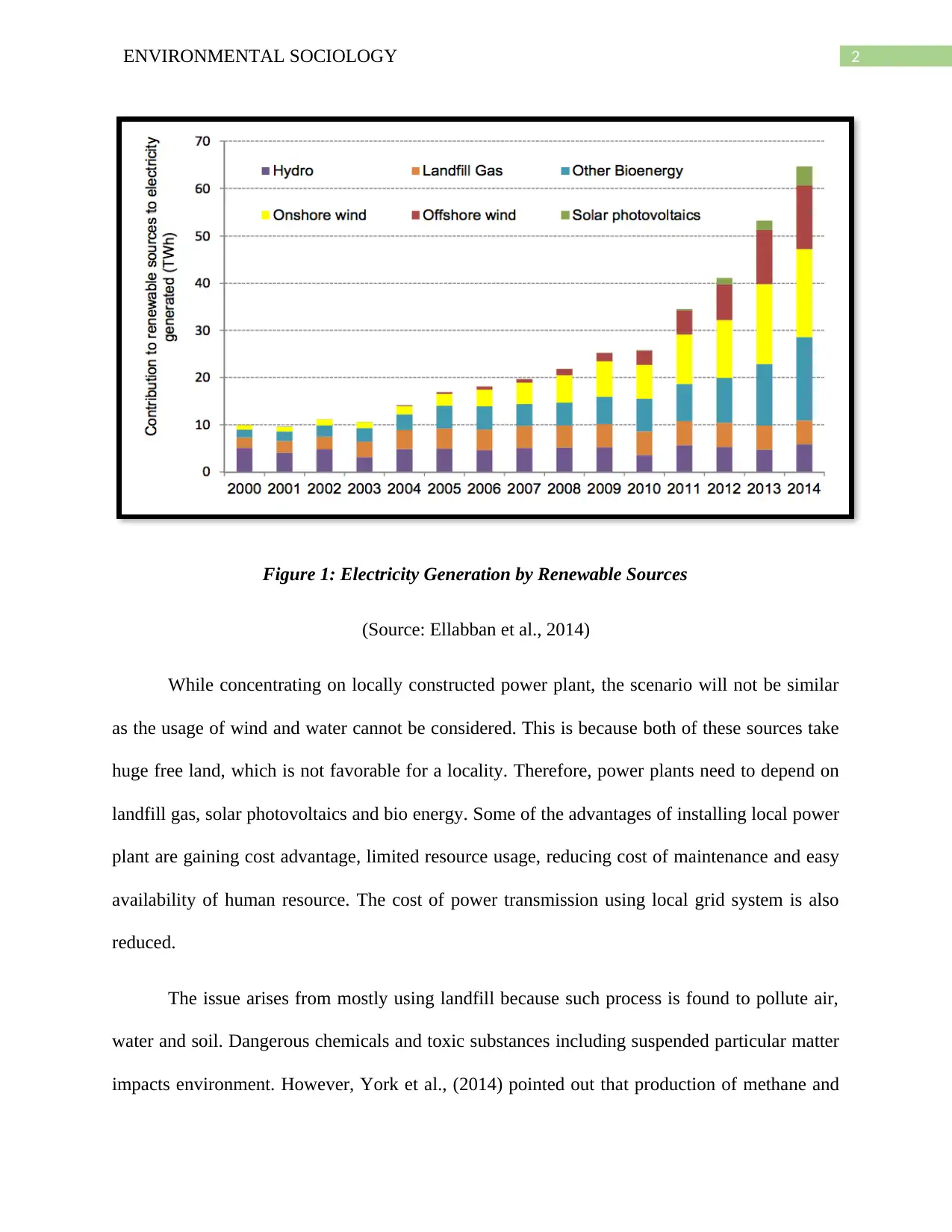
2ENVIRONMENTAL SOCIOLOGY
Figure 1: Electricity Generation by Renewable Sources
(Source: Ellabban et al., 2014)
While concentrating on locally constructed power plant, the scenario will not be similar
as the usage of wind and water cannot be considered. This is because both of these sources take
huge free land, which is not favorable for a locality. Therefore, power plants need to depend on
landfill gas, solar photovoltaics and bio energy. Some of the advantages of installing local power
plant are gaining cost advantage, limited resource usage, reducing cost of maintenance and easy
availability of human resource. The cost of power transmission using local grid system is also
reduced.
The issue arises from mostly using landfill because such process is found to pollute air,
water and soil. Dangerous chemicals and toxic substances including suspended particular matter
impacts environment. However, York et al., (2014) pointed out that production of methane and
Figure 1: Electricity Generation by Renewable Sources
(Source: Ellabban et al., 2014)
While concentrating on locally constructed power plant, the scenario will not be similar
as the usage of wind and water cannot be considered. This is because both of these sources take
huge free land, which is not favorable for a locality. Therefore, power plants need to depend on
landfill gas, solar photovoltaics and bio energy. Some of the advantages of installing local power
plant are gaining cost advantage, limited resource usage, reducing cost of maintenance and easy
availability of human resource. The cost of power transmission using local grid system is also
reduced.
The issue arises from mostly using landfill because such process is found to pollute air,
water and soil. Dangerous chemicals and toxic substances including suspended particular matter
impacts environment. However, York et al., (2014) pointed out that production of methane and
⊘ This is a preview!⊘
Do you want full access?
Subscribe today to unlock all pages.

Trusted by 1+ million students worldwide
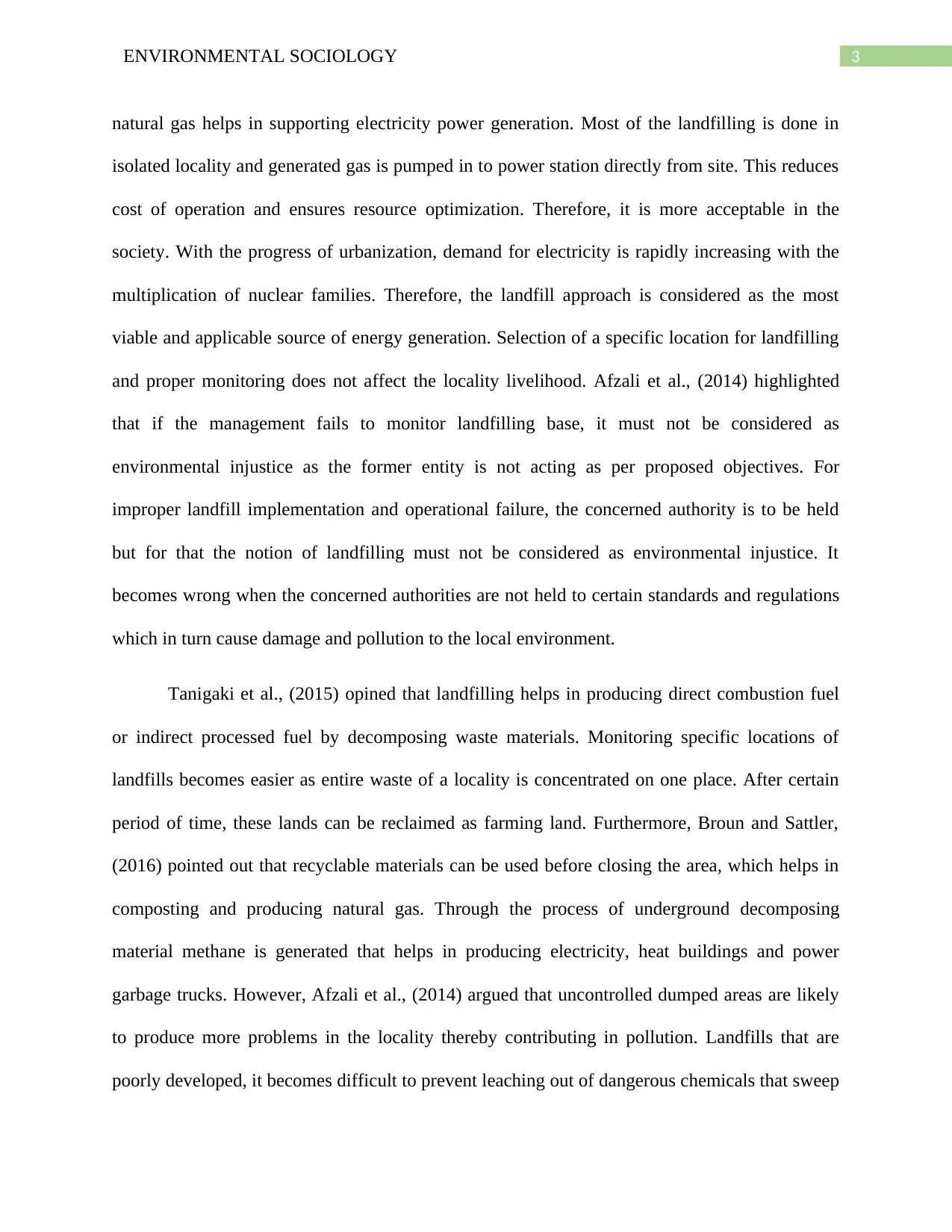
3ENVIRONMENTAL SOCIOLOGY
natural gas helps in supporting electricity power generation. Most of the landfilling is done in
isolated locality and generated gas is pumped in to power station directly from site. This reduces
cost of operation and ensures resource optimization. Therefore, it is more acceptable in the
society. With the progress of urbanization, demand for electricity is rapidly increasing with the
multiplication of nuclear families. Therefore, the landfill approach is considered as the most
viable and applicable source of energy generation. Selection of a specific location for landfilling
and proper monitoring does not affect the locality livelihood. Afzali et al., (2014) highlighted
that if the management fails to monitor landfilling base, it must not be considered as
environmental injustice as the former entity is not acting as per proposed objectives. For
improper landfill implementation and operational failure, the concerned authority is to be held
but for that the notion of landfilling must not be considered as environmental injustice. It
becomes wrong when the concerned authorities are not held to certain standards and regulations
which in turn cause damage and pollution to the local environment.
Tanigaki et al., (2015) opined that landfilling helps in producing direct combustion fuel
or indirect processed fuel by decomposing waste materials. Monitoring specific locations of
landfills becomes easier as entire waste of a locality is concentrated on one place. After certain
period of time, these lands can be reclaimed as farming land. Furthermore, Broun and Sattler,
(2016) pointed out that recyclable materials can be used before closing the area, which helps in
composting and producing natural gas. Through the process of underground decomposing
material methane is generated that helps in producing electricity, heat buildings and power
garbage trucks. However, Afzali et al., (2014) argued that uncontrolled dumped areas are likely
to produce more problems in the locality thereby contributing in pollution. Landfills that are
poorly developed, it becomes difficult to prevent leaching out of dangerous chemicals that sweep
natural gas helps in supporting electricity power generation. Most of the landfilling is done in
isolated locality and generated gas is pumped in to power station directly from site. This reduces
cost of operation and ensures resource optimization. Therefore, it is more acceptable in the
society. With the progress of urbanization, demand for electricity is rapidly increasing with the
multiplication of nuclear families. Therefore, the landfill approach is considered as the most
viable and applicable source of energy generation. Selection of a specific location for landfilling
and proper monitoring does not affect the locality livelihood. Afzali et al., (2014) highlighted
that if the management fails to monitor landfilling base, it must not be considered as
environmental injustice as the former entity is not acting as per proposed objectives. For
improper landfill implementation and operational failure, the concerned authority is to be held
but for that the notion of landfilling must not be considered as environmental injustice. It
becomes wrong when the concerned authorities are not held to certain standards and regulations
which in turn cause damage and pollution to the local environment.
Tanigaki et al., (2015) opined that landfilling helps in producing direct combustion fuel
or indirect processed fuel by decomposing waste materials. Monitoring specific locations of
landfills becomes easier as entire waste of a locality is concentrated on one place. After certain
period of time, these lands can be reclaimed as farming land. Furthermore, Broun and Sattler,
(2016) pointed out that recyclable materials can be used before closing the area, which helps in
composting and producing natural gas. Through the process of underground decomposing
material methane is generated that helps in producing electricity, heat buildings and power
garbage trucks. However, Afzali et al., (2014) argued that uncontrolled dumped areas are likely
to produce more problems in the locality thereby contributing in pollution. Landfills that are
poorly developed, it becomes difficult to prevent leaching out of dangerous chemicals that sweep
Paraphrase This Document
Need a fresh take? Get an instant paraphrase of this document with our AI Paraphraser
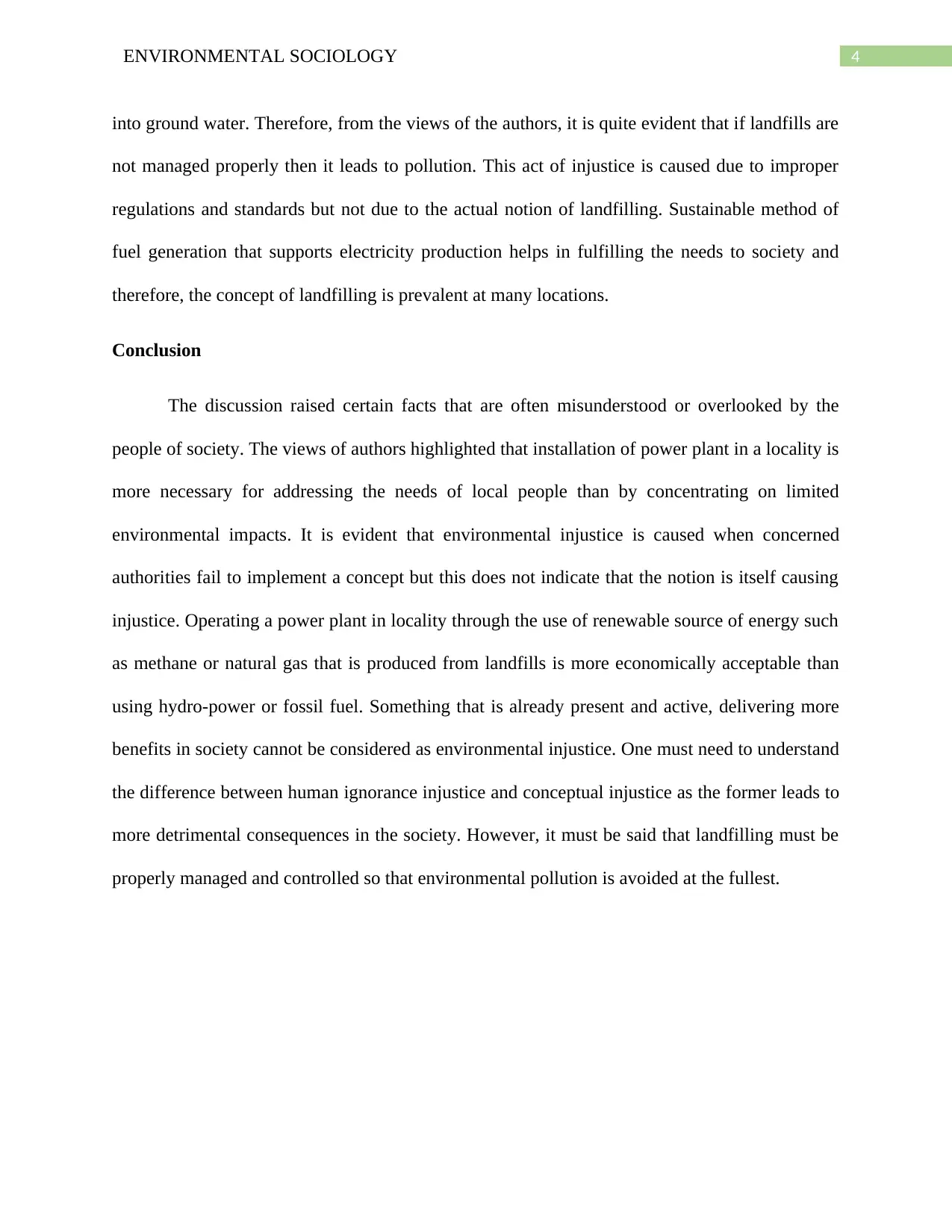
4ENVIRONMENTAL SOCIOLOGY
into ground water. Therefore, from the views of the authors, it is quite evident that if landfills are
not managed properly then it leads to pollution. This act of injustice is caused due to improper
regulations and standards but not due to the actual notion of landfilling. Sustainable method of
fuel generation that supports electricity production helps in fulfilling the needs to society and
therefore, the concept of landfilling is prevalent at many locations.
Conclusion
The discussion raised certain facts that are often misunderstood or overlooked by the
people of society. The views of authors highlighted that installation of power plant in a locality is
more necessary for addressing the needs of local people than by concentrating on limited
environmental impacts. It is evident that environmental injustice is caused when concerned
authorities fail to implement a concept but this does not indicate that the notion is itself causing
injustice. Operating a power plant in locality through the use of renewable source of energy such
as methane or natural gas that is produced from landfills is more economically acceptable than
using hydro-power or fossil fuel. Something that is already present and active, delivering more
benefits in society cannot be considered as environmental injustice. One must need to understand
the difference between human ignorance injustice and conceptual injustice as the former leads to
more detrimental consequences in the society. However, it must be said that landfilling must be
properly managed and controlled so that environmental pollution is avoided at the fullest.
into ground water. Therefore, from the views of the authors, it is quite evident that if landfills are
not managed properly then it leads to pollution. This act of injustice is caused due to improper
regulations and standards but not due to the actual notion of landfilling. Sustainable method of
fuel generation that supports electricity production helps in fulfilling the needs to society and
therefore, the concept of landfilling is prevalent at many locations.
Conclusion
The discussion raised certain facts that are often misunderstood or overlooked by the
people of society. The views of authors highlighted that installation of power plant in a locality is
more necessary for addressing the needs of local people than by concentrating on limited
environmental impacts. It is evident that environmental injustice is caused when concerned
authorities fail to implement a concept but this does not indicate that the notion is itself causing
injustice. Operating a power plant in locality through the use of renewable source of energy such
as methane or natural gas that is produced from landfills is more economically acceptable than
using hydro-power or fossil fuel. Something that is already present and active, delivering more
benefits in society cannot be considered as environmental injustice. One must need to understand
the difference between human ignorance injustice and conceptual injustice as the former leads to
more detrimental consequences in the society. However, it must be said that landfilling must be
properly managed and controlled so that environmental pollution is avoided at the fullest.
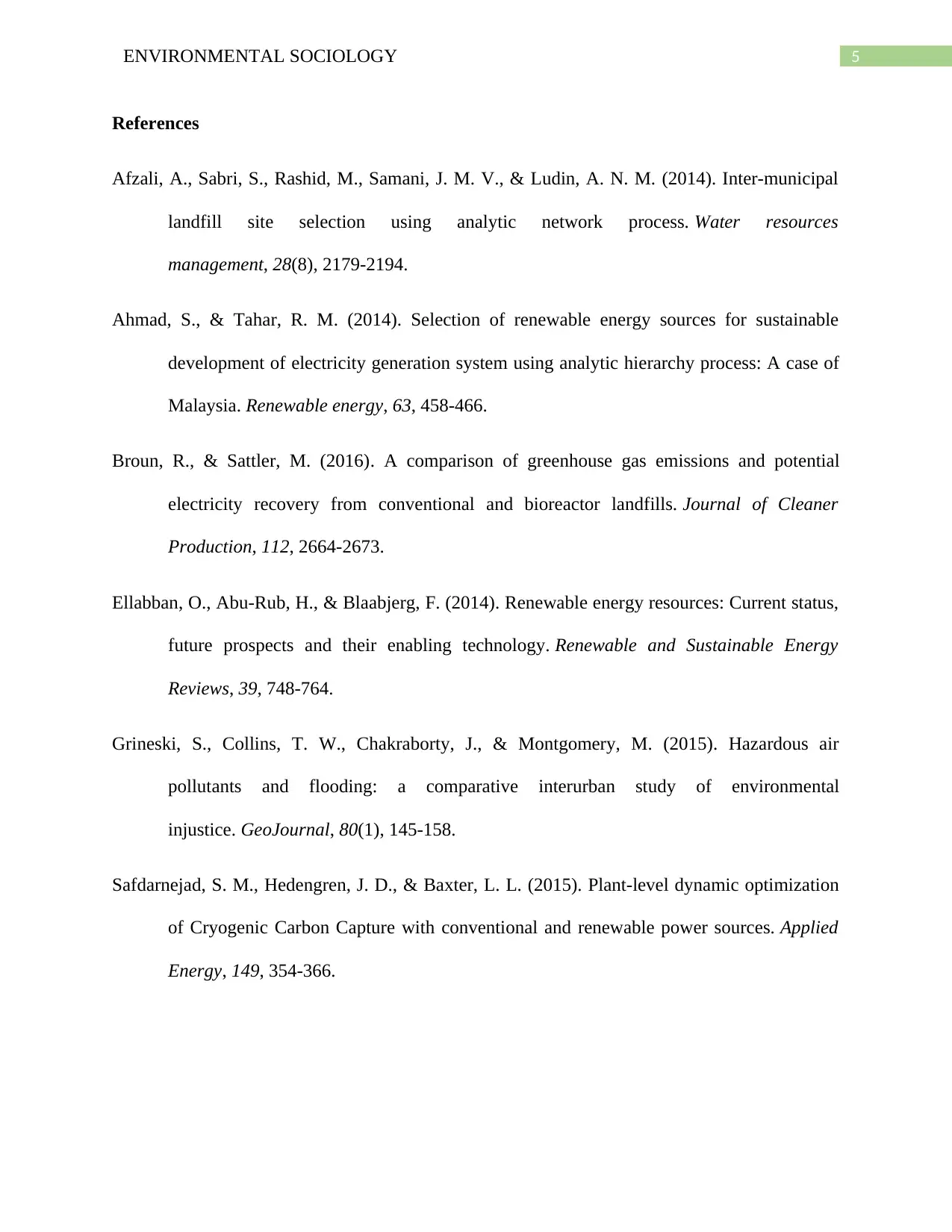
5ENVIRONMENTAL SOCIOLOGY
References
Afzali, A., Sabri, S., Rashid, M., Samani, J. M. V., & Ludin, A. N. M. (2014). Inter-municipal
landfill site selection using analytic network process. Water resources
management, 28(8), 2179-2194.
Ahmad, S., & Tahar, R. M. (2014). Selection of renewable energy sources for sustainable
development of electricity generation system using analytic hierarchy process: A case of
Malaysia. Renewable energy, 63, 458-466.
Broun, R., & Sattler, M. (2016). A comparison of greenhouse gas emissions and potential
electricity recovery from conventional and bioreactor landfills. Journal of Cleaner
Production, 112, 2664-2673.
Ellabban, O., Abu-Rub, H., & Blaabjerg, F. (2014). Renewable energy resources: Current status,
future prospects and their enabling technology. Renewable and Sustainable Energy
Reviews, 39, 748-764.
Grineski, S., Collins, T. W., Chakraborty, J., & Montgomery, M. (2015). Hazardous air
pollutants and flooding: a comparative interurban study of environmental
injustice. GeoJournal, 80(1), 145-158.
Safdarnejad, S. M., Hedengren, J. D., & Baxter, L. L. (2015). Plant-level dynamic optimization
of Cryogenic Carbon Capture with conventional and renewable power sources. Applied
Energy, 149, 354-366.
References
Afzali, A., Sabri, S., Rashid, M., Samani, J. M. V., & Ludin, A. N. M. (2014). Inter-municipal
landfill site selection using analytic network process. Water resources
management, 28(8), 2179-2194.
Ahmad, S., & Tahar, R. M. (2014). Selection of renewable energy sources for sustainable
development of electricity generation system using analytic hierarchy process: A case of
Malaysia. Renewable energy, 63, 458-466.
Broun, R., & Sattler, M. (2016). A comparison of greenhouse gas emissions and potential
electricity recovery from conventional and bioreactor landfills. Journal of Cleaner
Production, 112, 2664-2673.
Ellabban, O., Abu-Rub, H., & Blaabjerg, F. (2014). Renewable energy resources: Current status,
future prospects and their enabling technology. Renewable and Sustainable Energy
Reviews, 39, 748-764.
Grineski, S., Collins, T. W., Chakraborty, J., & Montgomery, M. (2015). Hazardous air
pollutants and flooding: a comparative interurban study of environmental
injustice. GeoJournal, 80(1), 145-158.
Safdarnejad, S. M., Hedengren, J. D., & Baxter, L. L. (2015). Plant-level dynamic optimization
of Cryogenic Carbon Capture with conventional and renewable power sources. Applied
Energy, 149, 354-366.
⊘ This is a preview!⊘
Do you want full access?
Subscribe today to unlock all pages.

Trusted by 1+ million students worldwide
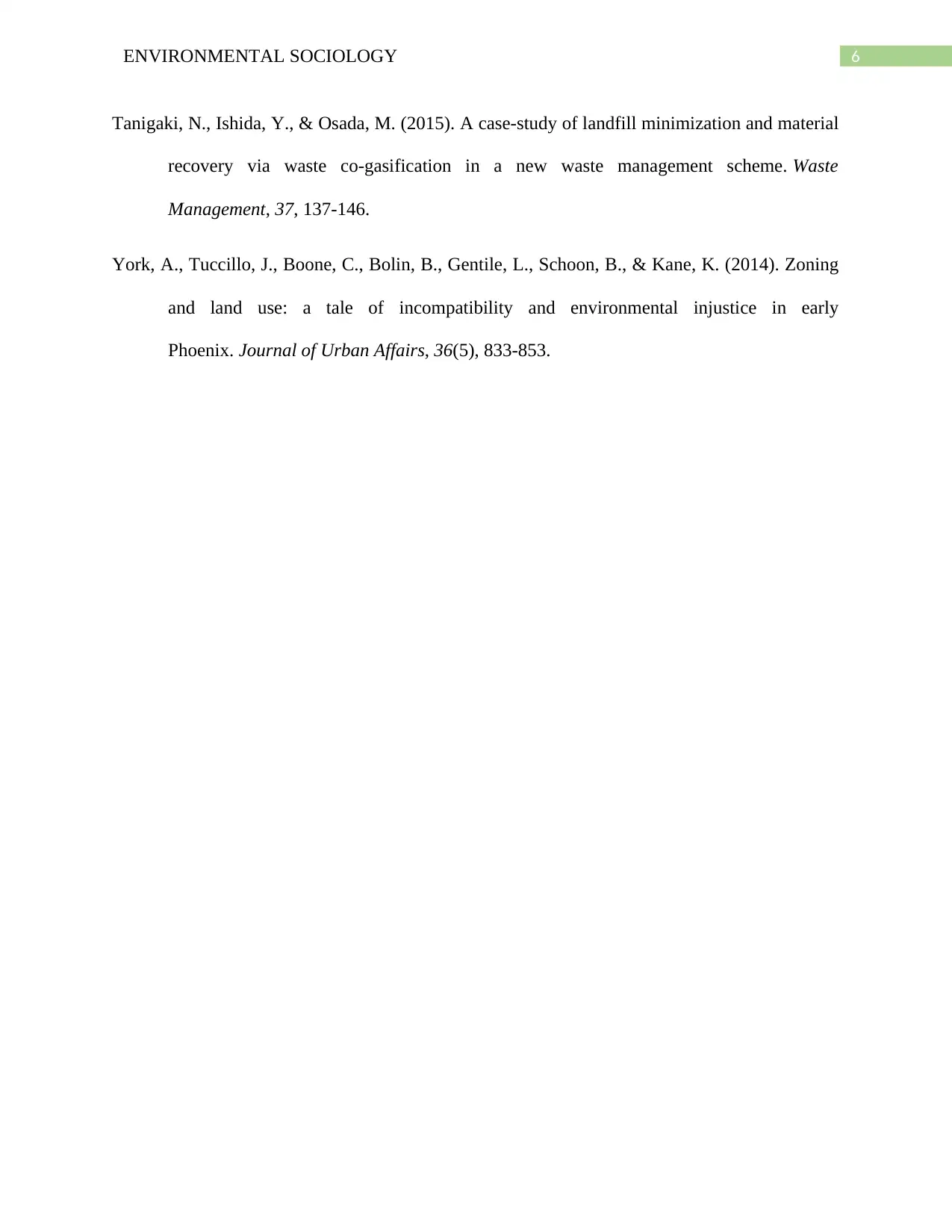
6ENVIRONMENTAL SOCIOLOGY
Tanigaki, N., Ishida, Y., & Osada, M. (2015). A case-study of landfill minimization and material
recovery via waste co-gasification in a new waste management scheme. Waste
Management, 37, 137-146.
York, A., Tuccillo, J., Boone, C., Bolin, B., Gentile, L., Schoon, B., & Kane, K. (2014). Zoning
and land use: a tale of incompatibility and environmental injustice in early
Phoenix. Journal of Urban Affairs, 36(5), 833-853.
Tanigaki, N., Ishida, Y., & Osada, M. (2015). A case-study of landfill minimization and material
recovery via waste co-gasification in a new waste management scheme. Waste
Management, 37, 137-146.
York, A., Tuccillo, J., Boone, C., Bolin, B., Gentile, L., Schoon, B., & Kane, K. (2014). Zoning
and land use: a tale of incompatibility and environmental injustice in early
Phoenix. Journal of Urban Affairs, 36(5), 833-853.
1 out of 7
Related Documents
Your All-in-One AI-Powered Toolkit for Academic Success.
+13062052269
info@desklib.com
Available 24*7 on WhatsApp / Email
![[object Object]](/_next/static/media/star-bottom.7253800d.svg)
Unlock your academic potential
Copyright © 2020–2025 A2Z Services. All Rights Reserved. Developed and managed by ZUCOL.





